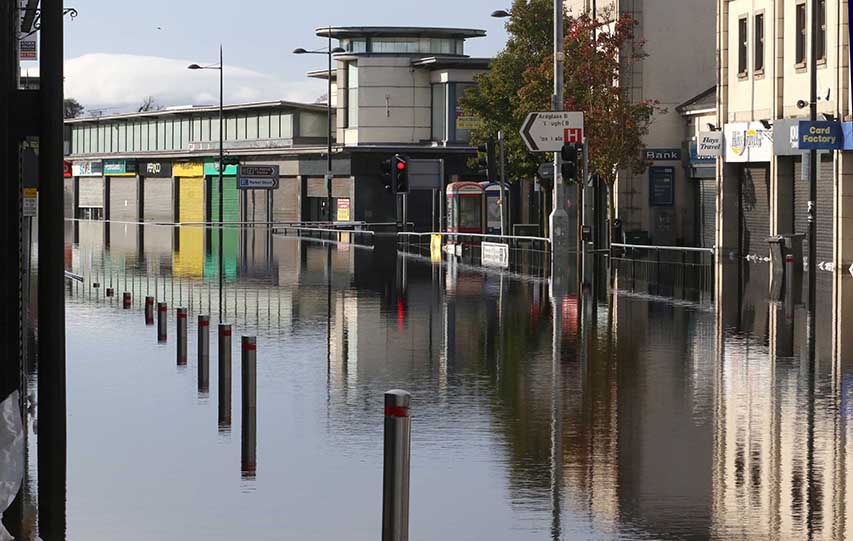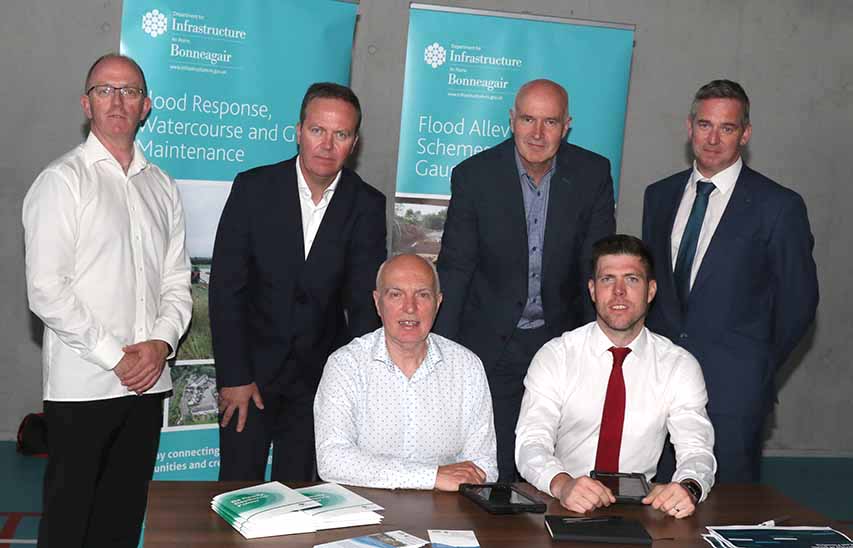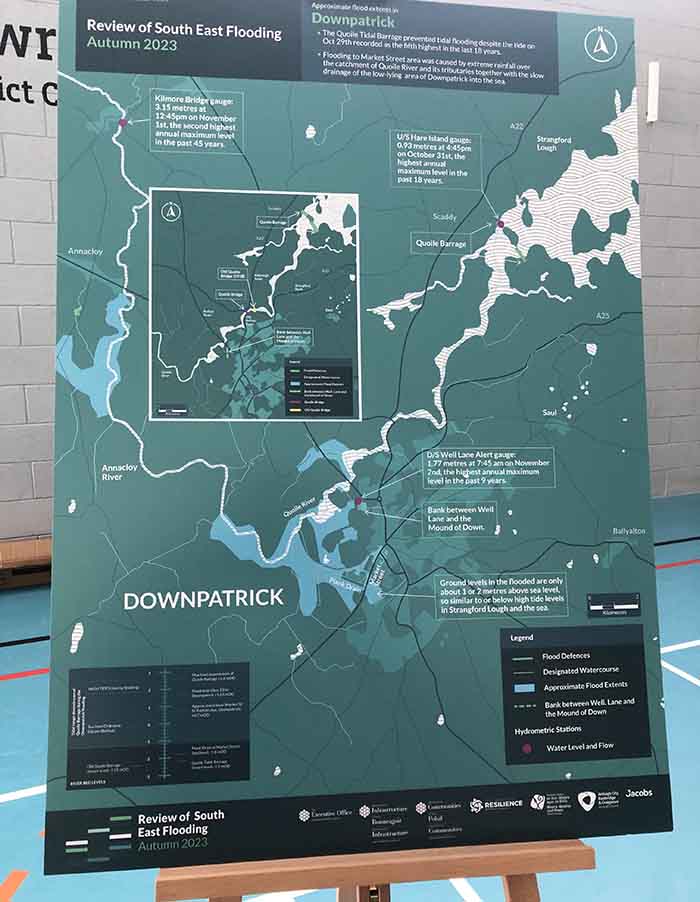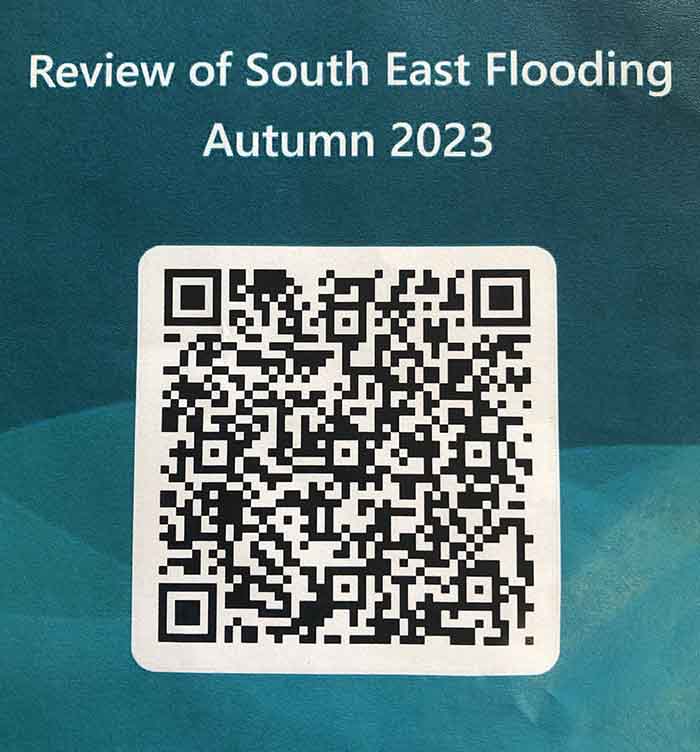Limited Options To Fix The Cause Of Downpatrick Flooding Discussed at Public Meeting In Down Leisure Centre
Down News attended the first session in the Down Leisure Centre of the ‘Review of the South East Flooding Autumn 2023‘ which was held on Thursday 27th June. There were two back-to-back sessions, the first starting at 4pm, the second at 6pm writes Jim Masson.
The first session was only lightly attended and got underway. The presenter was Triona O’Grady, a director of Jacobs Engineering Consultancy, who presented the findings on behalf of the multi-agency group, commissioned by the Department of Infrastructure to look at the flooding in the South East.

The review therefore focusses on the multi-agency response to the flooding in Downpatrick, Newcastle Newry, and Portadown, as well as providing a high level review of the cause of the flooding.
However, there was a technical drawback immediately encountered with very poor acoustics in the sports’ hall of the Down Leisure Centre and a significant number of people had difficulty in hearing the speaker.
The main take-away from this meeting is the complexity of addressing the flood prevention system particularly for Downpatrick and the fundamental reality that the River Quoile lies below the level of Strangford Lough which limits engineering responses.
One disgruntled business person said in conversation before the event started that : “These is always an engineering solution … if you throw enough money at it.”
This comment therefore presupposes that with the right political will, could the funding which will run into tens of millions be found through the Assembly?

With government departments already facing funding crises, Downpatrick could be left once ruminating over a parcel of consultants’ reports and promises that get lost in the bureaucratic rabbit-holes at Stormont and elsewhere.
The review presented by Jacobs, aimed to coordinate the Executive Office with the Department of Infrastructure, the local council (Newry Mourne and Down District Council, and the Department for Communities with the aim of planning future civil contingencies provisions.
The independent consultant Jacobs was tasked to carry out the review. The scope of the review focussed on the cause of the flooding and to present items for further consideration, then collate recommendations for future preparedness.
The review itself consisted of single agency debriefs, a multi-agency debrief, events for feedback from elected representatives and interest groups and a technical review which all led to the report.

The Presentation:
In the introduction, the background to the floods last October and November was explained by Triona O’Grady, Jacob’s consultancy.
There had been “unprecedented rainfall… which led to widespread flooding in the South East of Northern Ireland, causing significant damage and disruption,” she began. A fundamental statement that climate change was the key culprit in the recent flooding.
She added, that given the extent of the flooding, a review was triggered by the The NI Civil Contingencies Framework and the Joint Emergency Services Inoperability Programme (IESIP).
From October 26th to Wednesday 1 November, the South East region received more than double its average rainfall. This caused the river levels across the area to rise to record heights.
A map was provided setting out where the rain gauges were located in the South East in Armagh, Glenanne No 2, Katesbridge, Killowen, Murlough, and Stormont Castle.
The South East had faced its wettest May-October rainfall since 1890 and October 2023 showed more than 200% of a rainfall increase.
Subsequently, river level and flow increased significantly. The river catchment area over in the Ballynahinch direction recorded 3 highest record levels across different gauges. This system feeds into the River Quoile.
The Annacloy River at Kilmore Bridge is a gauging point and this river feeds into the River Quoile and an examination of flood probabilities showed that Downpatrick showed an Annual Exceedance Probability (AEP) of 4-5% which suggested a 1 in 20 – 25 chance of a flood re-occuring within one year.
Showing the context of the rainfall, it was reported that between 10-21st October 20203, 150 mm of rain fell on the Mournes, rushing down to the water systems.
Downpatrick: How the water level rose
On October 31st at 4.45pm at the Hare’s Island gauge, the highest annual maximum level in the past 18 years was reached beside the Quoile Barrier.
On November 1st, the Kilmore Bridge was showing 3.15 metres at 12.45pm, which was the second highest annual maximum level in the past 45 years.
On 2nd November ar 7.45am, at the Wells Lane gauge near the Mound of Down, the level had risen to 1.77metres which was the highest annual maximum level in the past 9 years.

Key Points on Downpatrick Flooding:
Without the Quoile Tidal barrage the treat of flooding in these areas would significantly increase.
The barrier safeguards the River Quoile floodplain and the low-lying areas of Downpatrick from tidal inundation.
In consideration of dredging the river to improve water flow, the river sits lower that Strangford Lough at low tide so if the river bed was dug out, the water would just flow back in again.
Therefore, dredging offers no benefit for Downpatrick drainage Triona O’Grady said.
GIVE FEEDBACK ON THE DOWNPATRICK MEETING BY SCANNING THE QR CODE FOR THE LINK
NOTE: This feedback consultation ends on Monday 1st July 2023. It just takes a minute!
One DfI official said it might be possible to hold some of the excess rainwater upstream and try and create a defence downstream. But that would need to be a design based on accurate data and research.
So, it’s an idea at the moment, but will be some time before – if ever – it finds its way through planning, design and implementation.
Newcastle:
Again the heavy rainfall was a factor in flooding. The Burren River and Shimna River flooded rapidly.
The report also indicated that surface water was aa factor in flooding.
And the sewer network does not have adaequate capacity to cope with the volume of flood water.
Input from Elected Reps Through Consultation:
This covered a number of areas including:
- roles, responsibilities and co-ordination,
- information and communication,
- insurance, aid and support,
- procedures and logistics.
For consideration – from the multi-agencies
- flood forecasting, flood warning, and real-time info sharing.
- building community resilience and public awareness.
- continue multi-agency training on response under the NI Civil Contingencies Framework.
- organisational resilience
- insurance and financial assistance to those flooded
- information for those at risk of flooding
- cross border arrangement
There was also a debrief of the work by the multi-agencies.
Their methodology was centred around: Prepare, Respond, and Recover.
The themes for the questionaire responses (see QR code) were:
- mproved awareness and communication,
- planning and coordination
- training and exercises, infrastructure and resources
- joint understanding of risk
- public engagement
- better linkage with health
- involvement of all relevant parties.
Moving forward, next steps:
There is an online feedback form available on a QR code and feedback for this closes by Monday 1st July.
The ‘Items for Consideration’ will be finalised through the process of ‘Recommendations’.
The final report will be launched asap.
The multi-agency partners present then met with the attendees in the Downpatrick Leisure Centre on a one-to-one basis and discussed matters further.
























